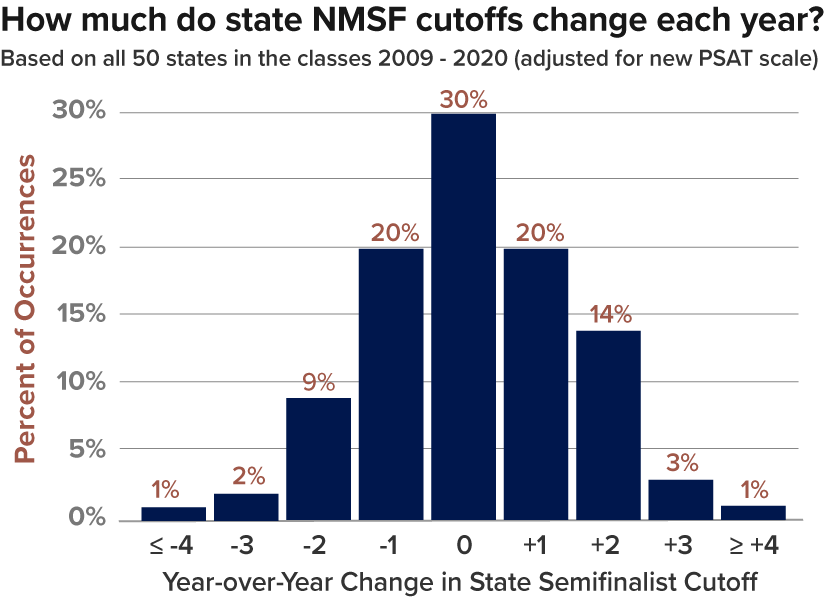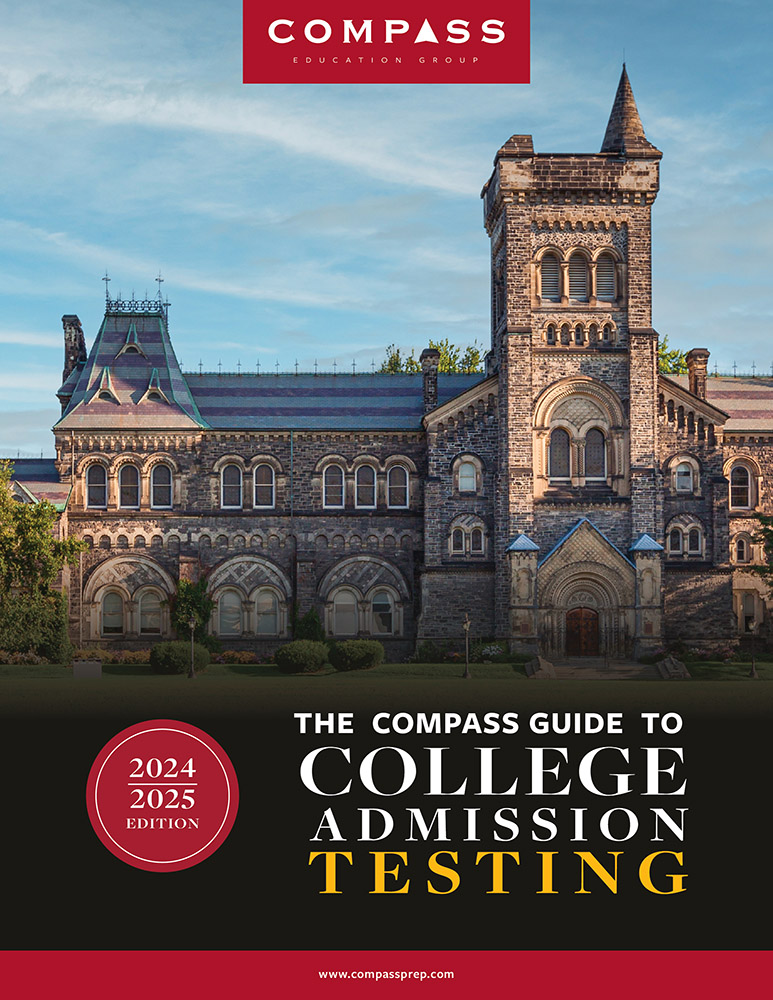
This is an archived page. Students looking for the most recent Semifinalist cutoff discussion can find it on our current page.
September 11 Update: NMSC has officially release Semifinalist information to the press, and schools are allowed to publicly share the information. Don’t panic if you have not yet heard anything. Some schools have still not received their packets. NMSC does not directly publish names, so you’ll only find lists online if your local paper or website publishes them. If you find complete state lists, please comment below with a link. I will try to aggregate those we have found. The cutoffs below are final. Lists available for: Arkansas, California, Florida, Idaho, Illinois, Maryland, Minnesota, Nebraska, New Jersey, New Mexico, New York, Texas, Washington.
Compass has now confirmed all of the National Merit cutoffs for the class of 2020. They range from the Commended Student cutoff at a PSAT Selection Index of 212 all the way to the 223 Selection Index cutoff in New Jersey and Massachusetts. The cutoffs determine the approximately 16,000 Semifinalists who will move forward in the National Merit Scholarship Program. An additional 35,000 students will receive Commended Student status.
The changes were the narrowest we have seen in more than a decade of tracking National Merit cutoffs. Students hitting last years’ targets were almost universally rewarded with Semifinalist status. Only Idaho’s cutoff moved up this year (from 214 to 215). Exactly half the states saw lower cutoffs this year, and twenty-four cutoffs were unchanged. No cutoff changed by more than 2 points — again, almost unprecedented stability. Below are the actual cutoffs for the class of 2020 compared to those of prior years. For students qualifying as Semifinalists, we recommend our National Merit FAQ to learn more about next steps such as the Finalist essay and confirming SAT and ACT scores.
| State | Class of 2020 | Chg | Class of 2019 | Class of 2018 | Class of 2017 | Typical # of Semifinalists |
|---|---|---|---|---|---|---|
| Alabama | 216 | 0 | 216 | 216 | 215 | 225 |
| Alaska | 213 | -2 | 215 | 217 | 213 | 40 |
| Arizona | 219 | -1 | 220 | 220 | 219 | 300 |
| Arkansas | 214 | 0 | 214 | 215 | 213 | 140 |
| California | 222 | -1 | 223 | 222 | 221 | 2,050 |
| Colorado | 220 | -1 | 221 | 220 | 218 | 245 |
| Connecticut | 221 | -1 | 222 | 221 | 220 | 185 |
| Delaware | 220 | -2 | 222 | 221 | 218 | 45 |
| District of Columbia | 223 | 0 | 223 | 223 | 222 | 50 |
| Florida | 219 | 0 | 219 | 219 | 217 | 810 |
| Georgia | 220 | 0 | 220 | 220 | 219 | 460 |
| Hawaii | 219 | -1 | 220 | 220 | 217 | 65 |
| Idaho | 215 | 1 | 214 | 216 | 214 | 85 |
| Illinois | 221 | 0 | 221 | 221 | 219 | 735 |
| Indiana | 218 | -1 | 219 | 219 | 217 | 335 |
| Iowa | 215 | -1 | 216 | 216 | 215 | 170 |
| Kansas | 218 | 0 | 218 | 219 | 217 | 155 |
| Kentucky | 217 | -1 | 218 | 217 | 215 | 215 |
| Louisiana | 215 | -2 | 217 | 216 | 214 | 210 |
| Maine | 215 | -2 | 217 | 215 | 214 | 75 |
| Maryland | 222 | -1 | 223 | 222 | 221 | 315 |
| Massachusetts | 223 | 0 | 223 | 222 | 222 | 345 |
| Michigan | 219 | 0 | 219 | 219 | 216 | 565 |
| Minnesota | 219 | -1 | 220 | 220 | 219 | 300 |
| Mississippi | 214 | -1 | 215 | 213 | 212 | 135 |
| Missouri | 217 | 0 | 217 | 217 | 216 | 335 |
| Montana | 214 | 0 | 214 | 214 | 210 | 50 |
| Nebraska | 216 | 0 | 216 | 215 | 215 | 100 |
| Nevada | 218 | 0 | 218 | 217 | 214 | 100 |
| New Hampshire | 218 | -1 | 219 | 217 | 216 | 75 |
| New Jersey | 223 | 0 | 223 | 223 | 222 | 520 |
| New Mexico | 213 | -2 | 215 | 215 | 213 | 90 |
| New York | 221 | 0 | 221 | 221 | 219 | 1,010 |
| North Carolina | 219 | -1 | 220 | 219 | 218 | 440 |
| North Dakota | 212 | 0 | 212 | 211 | 209 | 30 |
| Ohio | 218 | -1 | 219 | 219 | 217 | 615 |
| Oklahoma | 214 | -1 | 215 | 216 | 213 | 185 |
| Oregon | 220 | -1 | 221 | 220 | 219 | 180 |
| Pennsylvania | 220 | 0 | 220 | 219 | 218 | 680 |
| Rhode Island | 218 | -2 | 220 | 216 | 217 | 55 |
| South Carolina | 215 | -1 | 216 | 217 | 215 | 200 |
| South Dakota | 214 | -1 | 215 | 215 | 209 | 45 |
| Tennessee | 219 | 0 | 219 | 218 | 218 | 325 |
| Texas | 221 | 0 | 221 | 221 | 220 | 1,340 |
| Utah | 215 | 0 | 215 | 216 | 215 | 155 |
| Vermont | 216 | 0 | 216 | 217 | 215 | 40 |
| Virginia | 222 | 0 | 222 | 222 | 221 | 390 |
| Washington | 221 | -1 | 222 | 222 | 220 | 330 |
| West Virginia | 212 | 0 | 212 | 211 | 209 | 75 |
| Wisconsin | 216 | 0 | 216 | 217 | 215 | 330 |
| Wyoming | 212 | 0 | 212 | 213 | 209 | 25 |
| U.S. Territories | 212 | 0 | 212 | 211 | 209 | |
| U.S. Abroad | 223 | 0 | 223 | 223 | 222 | |
| Commended | 212 | 0 | 212 | 211 | 209 |
Eligible juniors with Selection Indexes at or above the relevant cutoffs will be named as Semifinalists. Students will receive confirmation from their schools. National Merit Scholarship Corporation asks that students not be publicly named until September 11, 2019, but many schools have been privately notifying students.
Why do states have such different cutoffs?
Cutoffs vary across the country because the 16,000 Semifinalists are allocated proportionally to states based on the total number of 11th graders in each state. A state’s cutoff is derived by finding the score that will produce, as closely as possible, the targeted number of Semifinalists. Students in any given state are competing only against fellow residents. The test is national; the competition is local. Boarding school students are a special case and must meet the highest state cutoff in their region.
Did cutoffs align with projections?
All of the Semifinalist cutoffs fell within the “most likely” range projected by Compass, but the number of states moving downward was surprising given continued growth in high PSAT scores (see table below).
 The number of students scoring at or above 1400 on the October 2018 PSAT increased over the prior two years. The increase was modest, so we were expecting modest changes in cutoffs. That turned out to be true, but the distribution of the changes was unusual. The most likely explanation is in the distinction between state and national results. While the Commended cutoff is driven by national performance, state cutoffs are independent of one another. A thousand additional California students could score 224 on the PSAT and it would have no impact at all on the cutoff in New Mexico, for example. We may get a better understanding when College Board eventually releases state PSAT data later this year.
The number of students scoring at or above 1400 on the October 2018 PSAT increased over the prior two years. The increase was modest, so we were expecting modest changes in cutoffs. That turned out to be true, but the distribution of the changes was unusual. The most likely explanation is in the distinction between state and national results. While the Commended cutoff is driven by national performance, state cutoffs are independent of one another. A thousand additional California students could score 224 on the PSAT and it would have no impact at all on the cutoff in New Mexico, for example. We may get a better understanding when College Board eventually releases state PSAT data later this year.
The high-water mark remains at 223.
As expected, 223 seems to be an upper limit for Semifinalist cutoffs. For the class of 2020, the only states to hit this mark were New Jersey and Massachusetts. The District of Columbia and U.S. Students Studying Abroad are “selection units” where the cutoff is set to the highest state cutoff, so they also came in at 223. We have yet to see a cutoff hit 224 since the revised PSAT debuted in 2016. For future years, we believe that a 224 cutoff is a remote possibility. New Jersey has the highest probability of an upward shift. A cutoff higher than 224 is not a realistic possibility in any state or selection unit within the foreseeable future. The cutoffs on the redesigned PSAT reach a natural limit. There are few score combinations that can even produce 225–228 Selection Indexes and not a sufficient number of students hitting those combinations.
Alternate reality
Perhaps the most talked about topic for the 2018 PSAT was the “alternate date” test given on October 24. The questions on this exam were easier than usual, resulting in a bizarrely harsh scale. Missing even two questions took students out of Semifinalist contention in the most competitive states. Only 10% of students took this form code, so we were expecting the national implications to be minor. The implications to individual students missing a couple of questions were far from minor. Once school-by-school data is released on Semifinalists, Compass will take a closer look at the impact of the October 24 PSAT.
What can the class of 2021 expect?
Class of 2021 students can view the current state cutoffs as approximate goals for their own Semifinalist hopes, but they should do so cautiously. Compass has done extensive research on fluctuations in PSAT scores and National Merit cutoffs. Over the last dozen class years, only 30% of cutoffs have remained unchanged from one year to the next. Approximately 38% of cutoffs have increased year-over-year in that period, sometimes by several points.
 Changes are not equally distributed across all states. High scoring states tend to have more stable cutoffs than those with cutoffs near the Commended level. States with fewer Semifinalists represent almost all of the largest jumps. Compass does additional research when PSAT scores are released in December and when the Commended cutoff becomes known in April.
Changes are not equally distributed across all states. High scoring states tend to have more stable cutoffs than those with cutoffs near the Commended level. States with fewer Semifinalists represent almost all of the largest jumps. Compass does additional research when PSAT scores are released in December and when the Commended cutoff becomes known in April.
I’m a Semifinalist, what comes next?
Our National Merit FAQ has the most detailed explanations on the steps in the National Merit Scholarship Program. Students choosing an ACT path can learn how, for the first time ever, NMSC will be incorporating ACT scores into the Finalist stage. We also have the SAT confirming score level, this year’s essay prompt, and information on how Finalists are selected.


For the Class of 2020: Are the following stats available to the public and if so, where can I find them listed? # of students who scored a 223+ nationally? By state?
Brooke,
Neither of those figures is available.